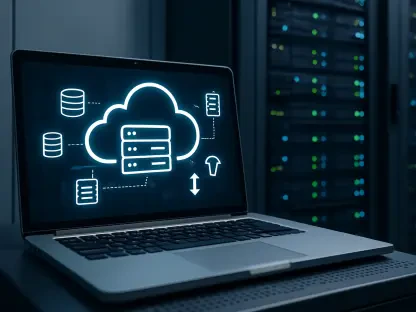In an age where transitioning to the cloud has become a standard for organizations, the evolution of compliance methods in cloud security has emerged as a crucial focus. With the numerous benefits of cloud solutions, including cost savings, flexibility, and operational efficiency, organizations are increasingly adopting these technologies. However, this shift brings about escalated complexities in ensuring compliance with various regulatory standards. The traditional methods of compliance, which involve periodic audits and manual checks, are proving to be inadequate and excessively time-consuming in this new environment.
The Shift from Traditional to Continuous Compliance in Cloud Security
Traditional Compliance Methods: An Overview
Traditional compliance methods, characterized by periodic audits and manual processes, have historically been the foundation for ensuring regulatory adherence. However, in the rapidly evolving cloud environment, these methods fall short. Periodic audits, often conducted annually or semi-annually, leave significant gaps in monitoring that can be exploited by cyber threats. Manual checks are time-consuming, labor-intensive, and prone to human error, significantly increasing the risk of non-compliance and security breaches. These hardships make traditional methods increasingly untenable in contemporary cloud settings. The need for a more reliable and efficient system is evident as organizations grapple with evolving threats and tighter regulatory standards.Given the pace at which technology—and consequently, cyber threats—are advancing, traditional compliance methods are becoming obsolete. The reactive nature of periodic audits means that compliance lapses can go unnoticed for extended periods, potentially leading to severe security breaches. This not only raises the risk of financial penalties but also damages organizational reputation and customer trust. Furthermore, the manual processes involved in traditional compliance require expansive use of human resources, increasing operational costs and diverting focus from strategic initiatives. Both elements underscore the urgent need for a more agile and proactive approach to compliance as organizations seek to protect their cloud environments effectively.
The Concept and Importance of Continuous Compliance
Continuous compliance represents a paradigm shift from these traditional methods. It involves leveraging automation to provide real-time monitoring and enforcement of compliance standards, thereby replacing static, periodic checks with dynamic, ongoing oversight. According to Gartner, by 2025, 60% of organizations are expected to adopt continuous compliance to mitigate cybersecurity risks effectively. This proactive approach ensures compliance is maintained consistently, reducing the likelihood of non-compliance and the associated financial and reputational risks. The benefits extend beyond mere adherence to regulations; continuous compliance fortifies the overall security posture by enabling organizations to detect and address vulnerabilities as they arise.The fundamental principle behind continuous compliance is its ability to integrate compliance activities directly into the operational workflows of an organization. This means that instead of waiting for an annual audit to uncover lapses, issues can be identified and rectified in real-time. Such an approach significantly diminishes the window of opportunity for cybercriminals to exploit vulnerabilities. Continuous compliance also enjoys the advantage of scalability, particularly crucial for large organizations operating across multiple jurisdictions. Real-time monitoring tools and automated compliance checks can seamlessly adapt to growing and changing regulatory landscapes, ensuring that the organization remains compliant irrespective of its size or the complexities of its operational regions.
The Role of Automation in Continuous Compliance
Real-Time Monitoring and Alerts
Automation technologies are at the heart of continuous compliance. By implementing real-time monitoring tools, organizations can constantly assess their cloud environments for compliance with regulatory standards. For instance, AWS Config continuously evaluates resource configurations and alerts administrators about any non-compliant resources, maintaining an up-to-date snapshot of compliance status. This immediacy allows organizations to address deviations promptly, upholding high compliance standards and mitigating risks. Real-time monitoring tools provide a dynamic, near-instantaneous snapshot of an organization’s security posture, allowing for swift, proactive responses.The benefits of real-time monitoring extend beyond simply identifying compliance issues. These tools can provide detailed insights into the operational health of cloud environments, enabling organizations to optimize resource usage and improve overall system performance. The continuous nature of monitoring means that even transient issues can be detected and addressed before they evolve into significant problems. Furthermore, real-time alerts empower organizations to take corrective actions swiftly, reducing the likelihood of prolonged non-compliance. By maintaining a perpetual state of readiness, continuous compliance not only enhances security but also builds a resilient organizational framework capable of adapting to the ever-changing landscape of cybersecurity threats and regulatory requirements.
Enhanced Security and Reduced Risk
The financial repercussions of non-compliance are severe. IBM reported that the average cost of a data breach in 2023 was $4.45 million, underscoring the catastrophic financial impact organizations can face. Automated compliance checks significantly reduce these risks by continuously scanning for vulnerabilities and configuration issues. Organizations can promptly mitigate potential threats, minimizing the likelihood of costly data breaches and regulatory fines, thereby enhancing overall security. The continuous nature of these checks ensures that security gaps are identified and remediated in real-time, providing an additional layer of protection against evolving cyber threats.Beyond financial implications, the reputation damage associated with non-compliance and security breaches can be long-lasting and detrimental. Automated compliance helps to shore up organizational reputations by providing assurance that stringent security measures are in place. Continuous scanning and real-time alerts allow for the swift identification and mitigation of vulnerabilities before they can be exploited. Moreover, by consistently updating and patching systems, organizations can stay ahead of potential threats, ensuring a robust security posture. Such proactive measures not only reduce immediate risks but also contribute to a culture of continuous improvement, fostering an environment where security and compliance go hand-in-hand.
Operational Efficiency through Automation
Automation streamlines the compliance process, reducing the workload on IT and security teams. Automated tools can generate compliance reports, track changes, and maintain audit trails effortlessly. This operational efficiency allows these teams to focus on more strategic initiatives, significantly enhancing overall productivity and resource utilization. By removing the need for extensive manual processes, organizations can reallocate resources to areas where they can have a more substantial strategic impact, driving innovation and growth. Automation serves as an enabling technology, allowing organizations to balance compliance obligations with broader business objectives.Furthermore, automation aids in maintaining a high level of accuracy in compliance activities. Manual processes are inherently prone to human error, which can lead to oversights and mistakes that compromise compliance and security. Automated systems, however, provide consistent, repeatable processes that ensure compliance checks are conducted to the same standard every time. This not only reduces the risk of non-compliance but also builds a comprehensive and accurate record of compliance activities. Over time, these records can provide valuable insights into compliance trends and potential areas for improvement, further strengthening the organization’s security posture and operational efficiency.
Future Trends in Continuous Compliance
The Influence of AI and Machine Learning
Artificial intelligence (AI) and machine learning (ML) are poised to play pivotal roles in the future of continuous compliance. These technologies can analyze vast datasets to uncover patterns and predict potential compliance issues before they become critical threats. AI-driven tools can detect anomalies in user behavior and flag potential security threats before they escalate, offering organizations a higher level of security and compliance management. By leveraging AI and ML, organizations can create a more intelligent, adaptive compliance system capable of evolving alongside emerging threats and regulatory requirements.The predictive capabilities of AI and ML extend beyond mere detection. These technologies can recommend proactive measures to prevent identified issues from developing into significant problems. For example, machine learning algorithms can identify common patterns associated with non-compliance incidents and suggest preemptive actions to mitigate these risks. The continuous learning aspect of these technologies also means that compliance systems become more refined and effective over time. As more data is analyzed, the algorithms’ ability to predict and prevent compliance issues improves, making the organization more resilient against future threats. This ongoing refinement ensures that compliance measures remain robust and effective, even as the regulatory landscape evolves.
Integration of Zero Trust Architecture
The zero trust security model, which operates on the principle that no entity should be trusted by default, is gaining momentum within cloud security frameworks. By aligning continuous compliance tools with zero trust principles, organizations can ensure consistent access controls and monitoring across cloud environments. This stringent verification process bolsters security and compliance by reducing the risk of unauthorized access and data breaches. Zero trust architecture operates under the assumption that threats can arise both inside and outside the network, necessitating rigorous verification for every access attempt.Adopting a zero trust model increases the resilience of continuous compliance systems. By requiring validation for every access request, this model minimizes the risk of insider threats and lateral movement within the network. Continuous compliance tools integrated with zero trust principles can monitor access patterns and detect irregularities, triggering immediate alerts and responses when potential security breaches are identified. This multi-layered security framework ensures that even if one layer is breached, additional protocols are in place to prevent further infiltration. Incorporating zero trust principles into continuous compliance strategies provides a comprehensive security shield, ready to defend against both current and future cyber threats.
The Challenge and Solutions for Global Regulatory Adherence
As organizations continue to operate on a global scale, complying with diverse regulatory standards across multiple regions becomes increasingly complex and resource-intensive. Future trends indicate the development of unified compliance frameworks that simplify adherence to these global standards. Such regulatory harmonization will streamline compliance efforts, enhance efficiency, and allow organizations to maintain high security and ethical standards across their global operations. By creating a universal set of compliance standards, organizations can reduce the complexity associated with managing multiple regional regulations.In addition to regulatory harmonization, technology can further alleviate the burden of global compliance adherence. Advanced compliance management platforms can automate the tracking and application of regulatory changes across different regions, ensuring that organizations remain compliant as laws evolve. These platforms can also provide centralized dashboards that offer real-time visibility into an organization’s compliance status across all jurisdictions. This holistic view simplifies the management of global compliance efforts and allows organizations to allocate resources more effectively. By leveraging unified frameworks and advanced technologies, organizations can achieve seamless compliance on a global scale, positioning themselves to thrive in an increasingly interconnected world.
Building Resilient Systems through Continuous Compliance
The Cost Savings and Long-Term Benefits
An IBM report from 2023 highlighted that companies implementing security, AI, and automation saved an average of $1.76 million compared to those that did not. This significant cost saving underscores the critical importance of adopting continuous compliance. Beyond immediate financial benefits, continuous compliance supports long-term organizational resilience by ensuring robust security measures are in place. By reducing the likelihood of costly data breaches and regulatory fines, organizations can reallocate financial resources towards innovation and growth, driving sustainable success in the digital era.Continuous compliance also fosters a culture of ongoing improvement and learning. Organizations that implement continuous compliance systems are better equipped to adapt to changing regulatory landscapes and emerging threats. This adaptability is crucial for maintaining a competitive edge in a rapidly evolving technological environment. By continually refining and enhancing their compliance strategies, organizations can build more resilient systems capable of withstanding future challenges. The investment in continuous compliance pays dividends not only in terms of cost savings but also by strengthening the organization’s overall security posture and operational efficiency.
Sustainable Growth in the Digital Landscape
In today’s era, transitioning to the cloud has become a standard practice for organizations, marking a significant focus on evolving compliance methods in cloud security. The adoption of cloud solutions comes with numerous advantages such as cost savings, enhanced flexibility, and improved operational efficiency. These factors are compelling more organizations to integrate cloud technologies into their operations. However, this shift also introduces increased complexities in maintaining compliance with various regulatory standards.Traditional methods of ensuring compliance, which typically rely on periodic audits and manual checks, are now proving to be outdated and excessively time-consuming in this fast-paced, cloud-centric landscape. The inefficiency of these traditional approaches necessitates the development of more advanced, automated compliance mechanisms that can keep up with the dynamic nature of cloud environments.Organizations must adopt more sophisticated compliance solutions that leverage automation and real-time monitoring to manage these complexities effectively. By doing so, they can ensure they meet regulatory requirements while fully harnessing the benefits of cloud technology.









